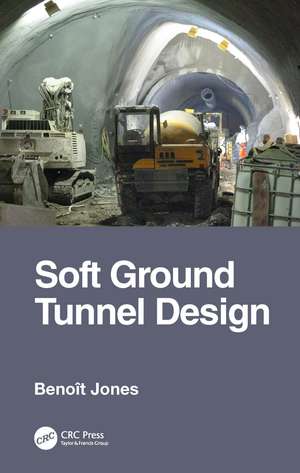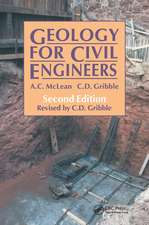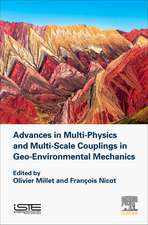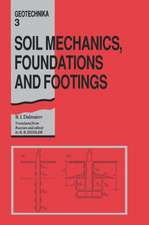Soft Ground Tunnel Design
Autor Benoit Jonesen Limba Engleză Paperback – 11 noi 2021
Benoît Jones builds on the basic principles of soil-structure interaction, the three-dimensional effects of construction sequence, and the effects of construction on other surface or subsurface structures in steps of gradually increasing complexity. The use of worked examples throughout, and example problems at the end of each chapter, give the reader confidence to apply their knowledge.
Engineers and graduate students will be able to:
• understand the basis for choosing an underground construction method and/or ground improvement method
• calculate heading stability
• predict ground movements
• understand the complex soil-structure interaction around an advancing tunnel
• design tunnel linings in soft ground using a variety of methods
• predict the effects of construction on the built environment and assess potential damage
Benoît Jones has worked in tunnelling as a designer, contractor and academic for more than 20 years. He set up and ran the MSc Tunnelling and Underground Space course at the University of Warwick. He is now managing director of his own company, Inbye Engineering.
| Toate formatele și edițiile | Preț | Express |
|---|---|---|
| Paperback (1) | 487.56 lei 43-57 zile | |
| CRC Press – 11 noi 2021 | 487.56 lei 43-57 zile | |
| Hardback (1) | 1272.54 lei 43-57 zile | |
| CRC Press – 11 noi 2021 | 1272.54 lei 43-57 zile |
Preț: 487.56 lei
Preț vechi: 529.96 lei
-8% Nou
Puncte Express: 731
Preț estimativ în valută:
93.30€ • 97.65$ • 77.65£
93.30€ • 97.65$ • 77.65£
Carte tipărită la comandă
Livrare economică 31 martie-14 aprilie
Preluare comenzi: 021 569.72.76
Specificații
ISBN-13: 9781482254679
ISBN-10: 1482254670
Pagini: 582
Ilustrații: 524
Dimensiuni: 156 x 234 x 34 mm
Greutate: 0.45 kg
Ediția:1
Editura: CRC Press
Colecția CRC Press
ISBN-10: 1482254670
Pagini: 582
Ilustrații: 524
Dimensiuni: 156 x 234 x 34 mm
Greutate: 0.45 kg
Ediția:1
Editura: CRC Press
Colecția CRC Press
Public țintă
Professional Practice & DevelopmentCuprins
1 Real tunnel behaviour
2 Undrained stability
3 Drained stability
4 Stability of shafts
5 Stability and Eurocode 7
6 Global design using analytical solutions
7 Global design using numerical modelling
8 Lining materials
9 Segmental lining design
10 Segment design for transient loads
11 Sprayed concrete lining design
12 Estimating ground movements
13 Estimating building damage
Appendix A: Derivation of wedge-prism method
Appendix B: Details from derivation of Curtis–Muir Wood equations
Appendix C: Derivation of the deflection of a rectangular simply supported beam under a point load
2 Undrained stability
3 Drained stability
4 Stability of shafts
5 Stability and Eurocode 7
6 Global design using analytical solutions
7 Global design using numerical modelling
8 Lining materials
9 Segmental lining design
10 Segment design for transient loads
11 Sprayed concrete lining design
12 Estimating ground movements
13 Estimating building damage
Appendix A: Derivation of wedge-prism method
Appendix B: Details from derivation of Curtis–Muir Wood equations
Appendix C: Derivation of the deflection of a rectangular simply supported beam under a point load
Notă biografică
Benoît Jones has worked in tunnelling as a designer, contractor and academic for more than 20 years. He set up and ran the MSc Tunnelling and Underground Space course at the University of Warwick, UK, and is now managing director of his own company, Inbye Engineering.
Recenzii
"This book is essential for the tunnel design engineer, of varying experience and maturity, with clear worked examples and referencing to assist throughout. It is a must for design organisations engaged within the tunnelling sector. ...[It] should be available to design engineers whether in an in-house client section, a consulting engineering practice or a contractor-based team. And a copy is essential for all libraries."
-- Paul Perry in Tunnels & Tunnelling
-- Paul Perry in Tunnels & Tunnelling
Descriere
This manual for the design of tunnels and underground spaces in soft ground focuses on stability, prediction of ground movements and structural design of the lining. It develops from basic principles of soil-structure interaction, through the effects of construction sequence, to the effects of construction on surface or subsurface structures.



















